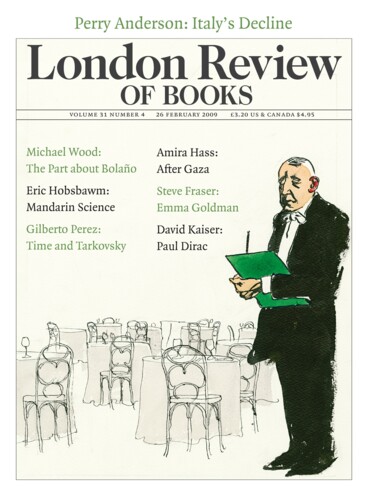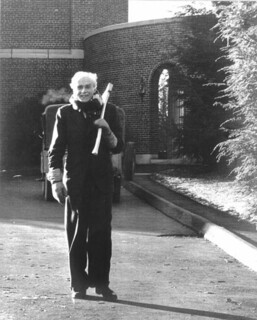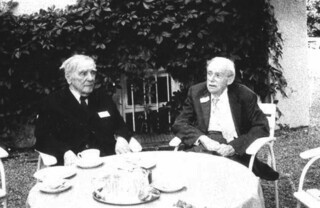Physics became ‘modern’ at breakneck speed. Only 20 years separated Einstein’s formulation of special relativity, in 1905, and the development of quantum mechanics in 1925-26. The two events have attracted rather different kinds of story. Einstein’s achievement is typically portrayed as the epic tale of one man’s obsession. The creation of quantum mechanics, on the other hand, required an ensemble that included Niels Bohr, who dressed like a banker and mumbled like an oracle; Werner Heisenberg, a gregarious Bavarian who was given to banging out Beethoven piano sonatas into the small hours and traipsing up mountains in Lederhosen; Louis de Broglie, a young French aristocrat, who studied literature and history before brazenly introducing the notion that solid matter might consist of waves; and Erwin Schrödinger, a dapper Austrian who led a surprisingly bohemian life: openly promiscuous, he sustained a string of affairs with much younger women (his biographer felt compelled to list ‘Lolita complex’ in the index), and raised, with his wife, the child he had by the wife of one of his assistants. Then there were the children who never grew up: practical jokers like the brilliant Russian Lev Landau or the acid-tongued Wolfgang Pauli.
They formed a tight-knit community. When not meeting at Bohr’s Institute for Theoretical Physics in Copenhagen, or at one of the informal conferences sponsored by the industrialist turned philanthropist Ernest Solvay, they kept up their conversations by letter. Tens of thousands of these letters have survived, and have been dutifully inventoried, archived, microfilmed and translated. And yet for all the attention lavished on the group – several biographies each of Bohr and Heisenberg, lengthy treatments of Schrödinger, Max Born and others – few have paid much attention to the British physicist Paul Dirac. Of all the characters who paraded through Bohr’s institute, it was the waifish and withdrawn Dirac whom Bohr called ‘the strangest man’.
As a young man, Dirac had dreamed of studying relativity. By the time he arrived in Cambridge in 1923 to study for a doctorate, however, the local expert on the subject had stopped taking students. Dirac was assigned instead to Ralph Fowler, at the time Britain’s foremost expert on the peculiar physics of atoms. Quantum theory was still an ungainly patchwork of models and heuristics, and physicists across Europe had been struggling for decades to make sense of matter at the smallest scales. The tendency was to begin with the familiar laws that govern everyday objects – the motion of planets in the solar system, or the interaction of electric charges and radiation – and then append this or that ad hoc rule to cover instances when the usual equations broke down.
Heisenberg set out to change all that. He and his peers sought a new quantum mechanics, a first-principles treatment of matter and radiation, which would replace the tattered, hand-me-down quilt of his teachers’ generation. Heisenberg was convinced that it was a mistake to rely on intuitions or models taken from ordinary physics. Electrons orbiting a nucleus in an atom were not like planets orbiting the Sun, he declared: the electrons’ paths could not be observed, even in principle. The best way forward, he announced in the opening paragraphs of his landmark article, written in 1925 when he was 23, was to construct a new theory ‘in which only relations between observable quantities occur’. This was the birth of matrix mechanics. In Heisenberg’s new formulation, arrays of discrete numbers replaced the smoothly varying quantities usually found in physicists’ equations and he filled his arrays with observable quantities, such as the colour and brightness of light emitted by atoms that had been excited by some outside source of energy.
Early in September 1925, Heisenberg posted a copy of the page proofs of his article to Fowler. Fowler, in turn, sent them to Dirac, still at his family home in Bristol for the summer vacation. Fowler appended a casual note: ‘What do you think of this? I shall be glad to hear.’ Dirac brushed aside Heisenberg’s opening challenge but noted something interesting later in the article. Some of the arrays of numbers in Heisenberg’s new scheme behaved in a curious way: their product depended on the order in which they were multiplied. A times B did not equal B times A. Unlike Heisenberg, Dirac had a degree in pure mathematics; such unconventional rules of multiplication reminded him of similar relationships that crop up in ordinary mechanics – the physics of tops, balls and orbiting planets – when written in a particularly advanced, mathematically elegant way. This buried mathematical analogy propelled Dirac forward: nine months later he completed his dissertation, using the analogy to clarify and generalise Heisenberg’s work.
By then, however, Heisenberg’s matrix mechanics was no longer the only game in town. During the winter of 1925, Schrödinger – ten years older than Heisenberg and Dirac, and far more conservative in his approach to physics – had produced an independent formulation. Instead of Heisenberg’s discrete arrays of numbers, so jarringly unfamiliar to most physicists, Schrödinger borrowed the familiar mathematics of waves, usually enlisted to describe such phenomena as ocean currents and sound. The contrast between Heisenberg’s and Schrödinger’s approaches stirred strong emotions. In one of his early articles on wave mechanics, Schrödinger wrote that he ‘felt discouraged, not to say repelled’ by Heisenberg’s methods. Heisenberg shot back, in a letter to a friend, that the more he thought about Schrödinger’s work, ‘the more disgusting I find it’.
Dirac’s dissertation earned him a scholarship to spend the 1926-27 academic year on the Continent. His first stop was Bohr’s institute in Copenhagen. There, ignoring most of his colleagues’ by-play, he sequestered himself in the library and demonstrated that Heisenberg and Schrödinger’s approaches were mathematically equivalent, the name-calling notwithstanding. Other people produced independent proofs of this, but most quantum physicists were quick to admire Dirac’s approach as the most powerful and elegant.
Dirac now produced a steady stream of breathtaking results. Just before leaving Bohr’s institute in January 1927, he extended the quantum formalism beyond atoms to radiation, creating a whole new physical theory. He called this ‘quantum electrodynamics’, or QED. Next he set about rectifying Heisenberg and Schrödinger’s equations with Einstein’s special theory of relativity, seeking to create a quantum mechanics that would hold together even as the objects under study moved at speeds closer and closer to the speed of light. Back in Cambridge in the autumn of 1927 (having been elected a fellow of St John’s College), he derived his relativistic equation for the electron, clarifying, along the way, the notion of quantum ‘spin’ that had puzzled his colleagues for years.
In the spring of 1931, under pressure from Heisenberg and Pauli to account for a strange mathematical feature of his new equation, Dirac boldly predicted the existence of antimatter: as yet unseen cousins to the ordinary particles we find all around us, which have the same mass but opposite electric charges. Within two years, physicists in California and Cambridge had accumulated striking experimental evidence in support of his conjecture. Dirac thus set in motion what has become the most precise physical theory ever. At the latest count, the predictions of QED match the results of experiments to 11 decimal places. Errors on both sides of the ledger – theorists’ calculations and experimenters’ data – are now measured in parts per trillion.
To Dirac, mathematics could be beautiful, and beauty was the surest guide to truth. ‘It is more important to have beauty in one’s equations than to have them fit experiment,’ he was fond of saying. (Proponents of string theory like to borrow his rhetoric.) A stickler for precision, Dirac developed a style that was elegant, even austere: colleagues sometimes complained that he left all the words out of his articles. Asked a question after a lecture, he often responded by repeating, verbatim, what he had said the first time. He honed his mathematical notation – now universal among physicists – to allow maximum economy of expression. His style was enshrined in his famous textbook, The Principles of Quantum Mechanics, first published in 1930 – in the course of his triumphant march from quantum mechanics to QED and beyond – and an instant classic. Eighty years later it is still in print, and still revered.
Unlike some less fortunate figures in the history of science, who suffered long delays before their contributions were recognised, Dirac rocketed to the top of the profession. He was elected to the Royal Society at the almost unheard of age of 27. In July 1932, just shy of his 30th birthday, he was elevated to the Lucasian Chair of Mathematics at Cambridge – once held by the equally precocious Isaac Newton. He shared the 1933 Nobel Prize for Physics with Schrödinger, and remains one of the youngest recipients. Though he was by no means finished as a physicist by this point – he continued to produce important, intriguing work in quantum theory and cosmology, most of which would bear fruit only later in the hands of others – the five-year period following his dissertation was one of the most brilliant and far-reaching bursts of scientific creativity ever known.
In other respects Dirac was a late bloomer. He seems to have become interested in politics only in his early thirties, when he developed a fascination with the ‘Soviet experiment’ – he made several trips to the USSR in the 1930s to collaborate with leading physicists. He stunned guests at the banquet in honour of his Nobel Prize by delivering an impromptu harangue on the importance of protecting workers’ wages in the midst of the global economic crisis.
He resisted getting involved in the war effort after 1939, although most of his colleagues in physics and mathematics rallied to the cause. He performed calculations for the ‘Tube Alloys’ project – Britain’s early nuclear weapons programme – and consulted on at least one occasion with Klaus Fuchs, the German-born British physicist who later spied for the Soviets from deep within the Manhattan Project. But when Robert Oppenheimer, the scientific director of the Los Alamos laboratory, asked him to work full-time on the Manhattan Project, Dirac declined.
His leftist sympathies gave him some problems after the war. He was denied a visa to enter the United States in May 1955, at the height of the anti-Communist hysteria. (The public rebuke came just as Oppenheimer was being interrogated by the Atomic Energy Commission’s personnel security board, although Oppenheimer’s case was secret at the time.) Nearly two decades later, as Dirac made plans to settle in the United States after his retirement, he was barred from accepting professorships at some universities because of his long-standing membership of the Soviet Academy of Sciences.
Yet these setbacks and embarrassments were minor compared with Dirac’s private struggles. Indeed, his success is all the more remarkable given the travails of his personal life. Six months before he was sent Heisenberg’s page proofs, his older brother, Felix, committed suicide. They had both studied engineering at the eminently practical Merchant Venturer’s College, the engineering faculty of Bristol University; their father taught French in the adjoining secondary school. Year after year, Felix had watched his younger brother gallop past him academically. Their father paid scant attention to Felix and refused to support his interest in medicine. To the end of his life, Dirac blamed his father for Felix’s death.
The Dirac household was crushingly joyless. Paul’s cold and authoritarian father spent decades in open feud with his mother. Drawing on a stash of family correspondence, Farmelo documents the efforts made by Dirac’s mother to gain solace from her younger son. She leaned on him for emotional support that few people in their teens or early twenties could be expected to provide, and this seems only to have pushed Paul deeper into his shell. In a country that has long celebrated reserved individuals, Dirac became a man of almost inhuman reticence. (In Cambridge a ‘Dirac’ was a unit of measurement corresponding to one word per hour, the ‘smallest imaginable number of words that someone with the power of speech could utter in company’, as Farmelo puts it.) Dirac explained late in life that his father had forced him to speak only French at the dinner table, and, frustrated by his lack of facility with the language, he had found it easiest to remain silent. In addition to that, or because of that, he developed severe indigestion and was afflicted by sensitivity to food throughout his life.
Retrospective diagnosis has become commonplace in our psychologising age, and family problems, combined with his peculiar demeanour, inevitably invite speculation. Farmelo marches through several traits commonly associated with autism – sensitivity to food and to loud, sudden noises; extreme reticence and awkward social behaviour; obsessive focus on a few arcane topics – adding each time that the appearance of similar traits in Dirac was probably not coincidental. In the end he can’t resist it: ‘I believe it to be all but certain that Dirac’s behavioural traits as a person with autism were crucial to his success as a theoretical physicist.’ Such claims demand a leap of faith. Lack of evidence is one problem. More serious, however, is the tacit assumption that our own repertoire of psychiatric diagnoses transcends time and place.
Send Letters To:
The Editor
London Review of Books,
28 Little Russell Street
London, WC1A 2HN
letters@lrb.co.uk
Please include name, address, and a telephone number.



